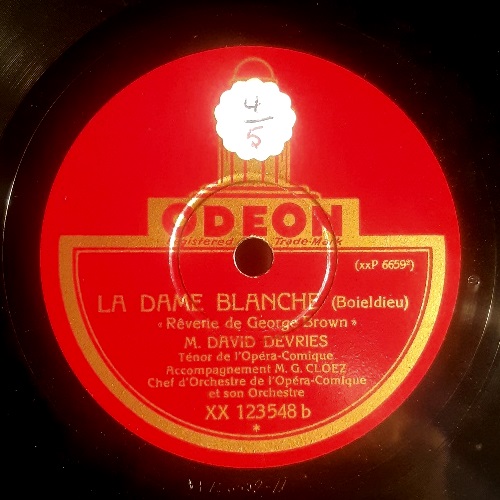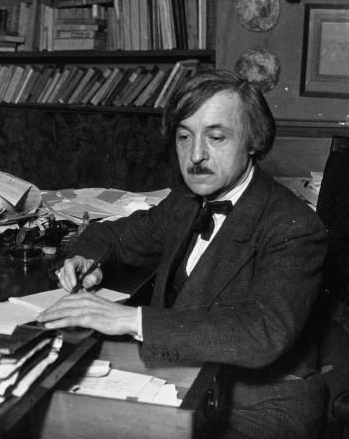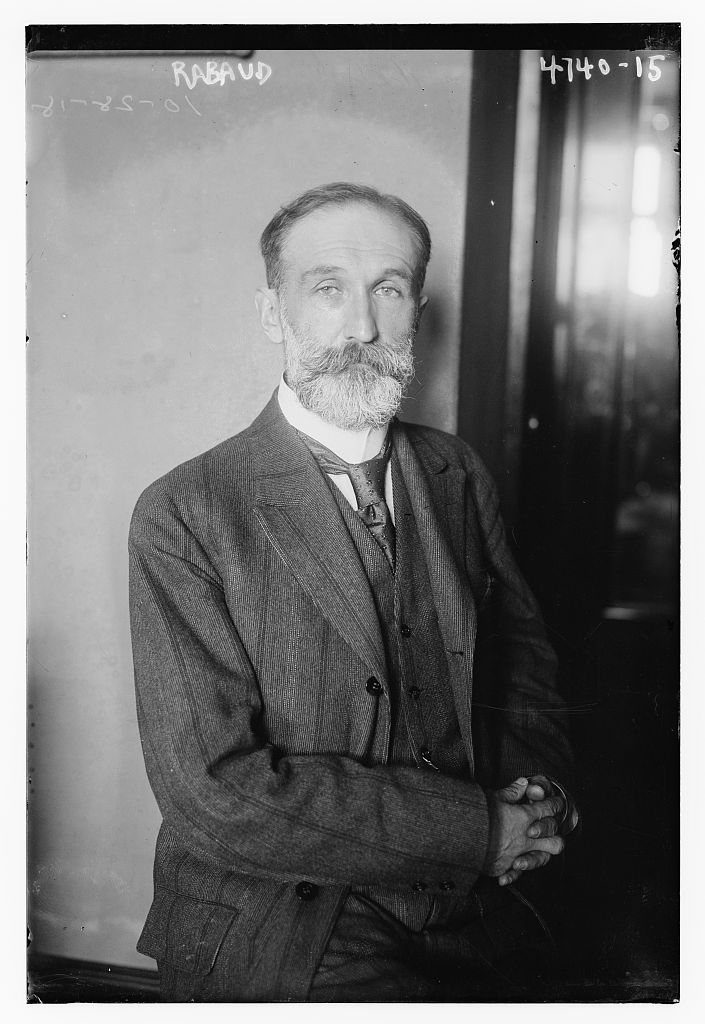|
David Devriès
David Devriès (born 14 February 1882 in Bagnères-de-Luchon, France; died 17 July 1936 in Neuilly-sur-Seine, France) was a French operatic lyric tenor noted for his light, heady tone, and polished phrasing. He represents a light style of French operatic singing that was popular in the 19th and 20th centuries. He was born into a family of professional singers that included his grandmother soprano Rosa de Vries-van Os (1828–1889), his aunts Fidès Devriès and Jeanne Devriès-Dereims, his uncles baritones Hermann Devriès (1854–1949) and Maurice Devriès (1856–1914), and his father Marcel-Louis Devriès (1849-1923), a chorister with the Paris Opera. David Devrès was also the half-brother of composer and conductor Henri Büsser (1872-1973). He studied at the Conservatoire de Paris and débuted in the role of Gérald in Delibes's ''Lakmé'' at the Opéra-Comique, where he regularly performed throughout his career. His repertoire included Almaviva, Don José, Toinet ... [...More Info...] [...Related Items...] OR: [Wikipedia] [Google] [Baidu] |
La Basoche
''La Basoche'' is an opéra comique in three acts, with music by André Messager and words by Albert Carré. The opera is set in Paris in 1514 and depicts the complications that arise when the elected "king" of the student guild, the Basoche, is mistaken for King Louis XII of France. The opera was first performed at the Opéra-Comique in Paris in 1890. Productions soon followed in continental Europe, Britain and the US. After that, the piece was revived repeatedly in France and elsewhere well into the 20th century. Background and first production During the 1880s Messager had met with mixed fortunes. His opérette '' La fauvette du temple'' (1885) and opéra comique '' La Béarnaise'' (1885) ran well, and his ballet '' Les deux pigeons'' (1886) was a box-office triumph. But in the late 1880s success eluded him, and he had three failures in a row: '' Le bourgeois de Calais'' (1888), '' Isoline'' (1888), and '' Le mari de la reine'' (1889).Wagstaff, John, and Andrew Lamb"Message ... [...More Info...] [...Related Items...] OR: [Wikipedia] [Google] [Baidu] |
Tosca
''Tosca'' is an opera in three acts by Giacomo Puccini to an Italian libretto by Luigi Illica and Giuseppe Giacosa. It premiered at the Teatro dell'Opera di Roma, Teatro Costanzi in Rome on 14 January 1900. The work, based on Victorien Sardou's 1887 French-language dramatic play, ''La Tosca'', is a melodramatic piece set in Rome in June 1800, with the Kingdom of Naples's control of Rome threatened by Napoleon's Campaigns of 1800 in the French Revolutionary Wars#Italy, invasion of Italy. It contains depictions of torture, murder, and suicide, as well as some of Puccini's best-known lyrical arias. Puccini saw Sardou's play when it was touring Italy in 1889 and, after some vacillation, obtained the rights to turn the work into an opera in 1895. Turning the wordy French play into a succinct Italian opera took four years, during which the composer repeatedly argued with his librettists and publisher. ''Tosca'' premiered at a time of unrest in Rome, and its first performance was delayed ... [...More Info...] [...Related Items...] OR: [Wikipedia] [Google] [Baidu] |
Madame Butterfly
''Madama Butterfly'' (; ''Madame Butterfly'') is an opera in three acts (originally two) by Giacomo Puccini, with an Italian libretto by Luigi Illica and Giuseppe Giacosa. It is based on the short story "Madame Butterfly" (1898) by John Luther Long, which in turn was based on stories told to Long by his sister Jennie Correll and on the semi-autobiographical 1887 French novel '' Madame Chrysanthème'' by Pierre Loti.Chadwick Jenna"The Original Story: John Luther Long and David Belasco" on columbia.edu Long's version was dramatized by David Belasco as the one-act play '' Madame Butterfly: A Tragedy of Japan'', which, after premiering in New York in 1900, moved to London, where Puccini saw it in the summer of that year. The original version of the opera, in two acts, had its premiere on 17 February 1904 at La Scala in Milan. It was poorly received, despite having such notable singers as soprano Rosina Storchio, tenor Giovanni Zenatello and baritone Giuseppe De Luca in lead roles ... [...More Info...] [...Related Items...] OR: [Wikipedia] [Google] [Baidu] |
Werther
''Werther'' is an opera (''drame lyrique'') in four acts by Jules Massenet to a French libretto by Édouard Blau, Paul Milliet and Georges Hartmann (who used the pseudonym Henri Grémont). It is loosely based on Goethe's epistolary novel ''The Sorrows of Young Werther'', which was based both on fact and on Goethe's own early life. Earlier examples of operas using the story were made by Kreutzer (1792) and Pucitta (1802). Milnes R. Werther. In: ''The New Grove Dictionary of Opera''. Macmillan, London and New York, 1997. Performance history Massenet started composing ''Werther'' in 1885, completing it in 1887. He submitted it to Léon Carvalho, the director of the Paris Opéra-Comique, that year, but Carvalho declined to accept it on the grounds that the scenario was too serious. With the disruption of the fire at the Opéra-Comique and Massenet's work on other operatic projects (especially ''Esclarmonde''), it was put to one side, until the Vienna Opera, pleased with the succes ... [...More Info...] [...Related Items...] OR: [Wikipedia] [Google] [Baidu] |
Manon
''Manon'' () is an ''opéra comique'' in five acts by Jules Massenet to a French libretto by Henri Meilhac and Philippe Gille, based on the 1731 novel '' L'histoire du chevalier des Grieux et de Manon Lescaut'' by the Abbé Prévost. It was first performed at the Opéra-Comique in Paris on 19 January 1884, with sets designed by Eugène Carpezat (act 1), Auguste Alfred Rubé and Philippe Chaperon (acts 2 and 3), and Jean-Baptiste Lavastre (act 4). Prior to Massenet's work, Halévy (''Manon Lescaut'', ballet, 1830) and Auber (''Manon Lescaut'', opéra comique, 1856) had used the subject for musical stage works. Massenet also wrote a one-act sequel to ''Manon'', ''Le portrait de Manon'' (1894), involving the Chevalier des Grieux as an older man. The composer worked at the score of ''Manon'' at his country home outside Paris and also at a house at The Hague once occupied by Prévost himself. ''Manon'' is Massenet's most popular and enduring opera and, having "quickly conquered th ... [...More Info...] [...Related Items...] OR: [Wikipedia] [Google] [Baidu] |
Raoul Laparra
Raoul Laparra (13 May 1876 – 4 April 1943) was a French composer. Life Born in Bordeaux, Laparra studied at the Conservatoire de Paris with André Gedalge, Jules Massenet, Gabriel Fauré and Albert Lavignac. In 1903 he won the Premier Grand Prix de Rome with his cantata ''Alyssa''. Laparra worked as a music critic for the magazines ''Le Ménestrel'' and ''Le Matin'' and taught at the Conservatoire de Paris. Among his students were Claude Champagne and Cemal Reşit Rey. His compositions are often influenced by Spanish and Basque folk music. He remains one of the masters of French Hispanism without remaining locked up in this speciality. He was the brother of the painter William Laparra. He died during the bombing of Boulogne-Billancourt in 1943 and is buried in Chézy-sur-Marne. Selected works * ''Peau d'âne'', Opera, 1899 * ''La Habanera'', Drame lyrique, 1900–1903 [...More Info...] [...Related Items...] OR: [Wikipedia] [Google] [Baidu] |
Mignon
''Mignon'' is an 1866 ''opéra comique'' (or opera in its second version) in three acts by Ambroise Thomas. The original French libretto was by Jules Barbier and Michel Carré, based on Goethe's 1795-96 novel '' Wilhelm Meisters Lehrjahre''. The Italian version was translated by Giuseppe Zaffira. The opera is mentioned in James Joyce's " The Dead" (''Dubliners'') and Willa Cather's '' The Professor's House''. Thomas's goddaughter Mignon Nevada was named after the main character. Performance history The first performance was at the Opéra-Comique in Paris on 17 November 1866. The piece proved popular: more than 100 performances took place by the following July, the 1,000th was given there on 13 May 1894, and the 1,500th on 25 May 1919. The opera was also adapted and translated into German for performance in Berlin with Madame Lucca as Mignon. Lucca was well received, but the German critics were unhappy with the opera's alterations to the Goethe original, so Thomas composed a shor ... [...More Info...] [...Related Items...] OR: [Wikipedia] [Google] [Baidu] |
Mireille (opera)
''Mireille'' is an 1864 opera in five acts by Charles Gounod to a French libretto by Michel Carré after Frédéric Mistral's poem Mirèio. The vocal score is dedicated to George V of Hanover. Composition history Mistral had become well known in Paris with the publication of the French prose translation of ''Mireio'' in 1859, and Gounod probably knew the work by 1861.Huebner 1992. He was charmed by its originality, the story being much less contrived than many of those on the operatic stage at the time.Condé G. Mireille (notes for the 1979 EMI recording). The action of the opera is quite faithful to Mistral, although the sequence of events of the Val d’Enfer (Act 3, Scene 1) and Mireille's avowal of her love of Vincent to her father (Act 2 finale) are reversed in the opera. Gounod's biographer James Harding has argued that "what matters in this extended lyric poem is not the story but the rich tapestry of Provençal traditions, beliefs and customs that Mistral unfolds." Durin ... [...More Info...] [...Related Items...] OR: [Wikipedia] [Google] [Baidu] |
Mârouf, Savetier Du Caire
''Mârouf, savetier du Caire'' (''Marouf, Cobbler of Cairo'') is an '' opéra comique'' by the French composer Henri Rabaud. The libretto, by Lucien Nepoty, is based on a tale from the '' Arabian Nights''. ''Mârouf'' was first performed at the Opéra-Comique, Paris, on 15 May 1914. The premiere was a great success and ''Mârouf'' became Rabaud's most popular opera. The score makes great use of oriental colour. The United States premiere of the opera was given at the Metropolitan Opera on December 19, 1917, with Giuseppe De Luca in the title role, Frances Alda as Princess Saamcheddine, and Pierre Monteux conducting. The Viennese premiere was at the Vienna State Opera The Vienna State Opera (, ) is an opera house and opera company based in Vienna, Austria. The 1,709-seat Renaissance Revival venue was the first major building on the Vienna Ring Road. It was built from 1861 to 1869 following plans by August ... on 24 January 1929, with Josef Kalenberg and Margit Angerer ( ... [...More Info...] [...Related Items...] OR: [Wikipedia] [Google] [Baidu] |
Henri Rabaud
Henri Benjamin Rabaud (10 November 187311 September 1949) was a French conductor, composer and pedagogue, who held important posts in the French musical establishment and upheld mainly conservative trends in French music in the first half of the twentieth century.Girardot A. Henri Rabaud. In: ''The New Grove Dictionary of Opera.'' Macmillan, London and New York, 1997.Landormy P. ''La Musique Française après Debussy.'' Gallimard, Paris, 1943. Life and career Rabaud came from a musical background. He was the son of a cellist Hippolyte Rabaud (1839–1900), professor of cello at the Paris Conservatoire, while his mother was a singer who almost created the role of Marguérite at the request of Charles Gounod. His maternal grandfather was a well-known flautist, while his great aunt was Julie Dorus-Gras. Henri studied at the Conservatoire with André Gedalge and Jules Massenet. In 1908, he became a conductor at the Paris Opéra-Comique where he later conducted the 100th perf ... [...More Info...] [...Related Items...] OR: [Wikipedia] [Google] [Baidu] |
Sapho (Massenet)
("lyric play", an opera in a declamatory style) in five acts. The music was composed by Jules Massenet to a French libretto by Henri Cain and Arthur Bernède, based on the novel (1884) of the same name by Alphonse Daudet. It was first performed on 27 November 1897 by the Opéra Comique at the Théâtre Lyrique on the Place du Châtelet in Paris with Emma Calvé as Fanny Legrand. A charming and effective piece, the success of which is highly dependent on the charisma of its lead soprano, it has never earned a place in the standard operatic repertory. Performance history In its first production in 1897 ''Sapho'' was presented in a heavily truncated form of four tableaux, due to the limited availability of Calvé, as well as the approaching death of Daudet (who was a close friend of Massenet), and the acting deficiencies of the tenor Leprestre, who was playing the romantic lead role of Jean Gaussin. In this initial run at the Opéra-Comique, the opera received 42 performance ... [...More Info...] [...Related Items...] OR: [Wikipedia] [Google] [Baidu] |









.jpg)